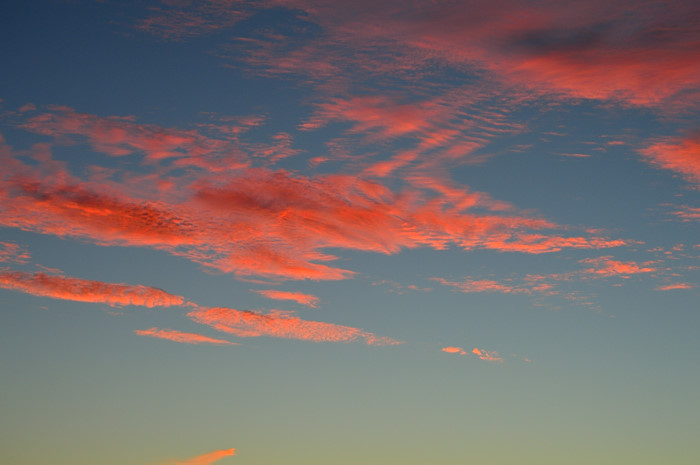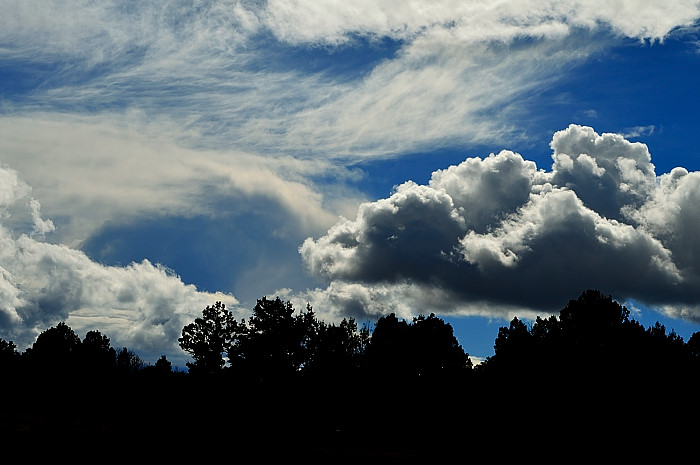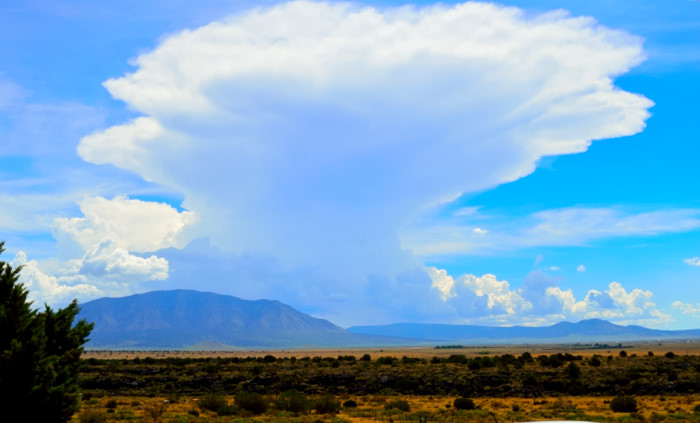
“It was a dark and stormy night” is an infamous bromide that has launched a million pulp romance novels. In a few words it conjures emotions we’ve all experienced before. Weather and clouds express mood—nature’s emojis. Somewhere in our past, each of us has lazed serenely under a gentle summer breeze and a brilliant sky filled with clouds as fluffy as fresh picked cotton. There’s that sense of renewal after a thunderstorm—the wet streets and slices of blue flashing through bunched clouds—a rumor of sunshine, the heavy earth smell of rain. And who hasn’t felt the desire to curl up with a good book when thin gray clouds smear above a paralyzed winter landscape? In springtime, as the land momentarily flashes shadows from rags of clouds ghosting across the sky, optimism soars. But everything is temporary. Fleeting clouds are about the moment. We are alive right here, right now; the only time that matters to a beating heart.

Since our planet’s birth, there have been clouds. We often consider them to be uniquely ours but they aren’t. Venus, Mars, Jupiter, Neptune, Uranus and Saturn have clouds too. The thing is, while they make weather wherever they exist, it takes sentient consciousness—something with feelings— to contemplate them, to appreciate, to dream. And it’s an ever-changing show up there. Of course there are cloudless days, but on days when they are present clouds are like newly composed symphonies. Each moment brings something fresh and new, swirling, shifting, emerging and receding. And clouds tell stories. The storylines are truly infinite, just like the heavens they inhabit. Clouds speak to people either as a solo performer scudding across the sky or as grand tapestries covering the entire firmament with lace. So beautiful, so majestic that anyone with a soul can’t fail to be moved by them.

Man has been captivated by clouds from the get go. They have played an important role in different cultures and religious traditions through the ages. In Exodus 13:21-22, Yahweh is described as guiding the Israelites through the desert in the form of a “pillar of cloud.” In an ancient Greek comedy (The Clouds) first performed in 423 BC, Socrates declares that “the clouds are the only deities.” Likewise, clouds have inspired innumerable poets and philosophers for eons. Clouds still continue to influence daily life. In China, clouds are widely considered symbols of luck and happiness. In the western world, clouds saturate our everyday speech (cloud nine), our songs (Get Off of My Cloud!), our literature (Lake in the Clouds,) and our art (Georgia O’Keefe’s “Sky Above Clouds”). Clouds even filter down to our geology. Some of the highest mountains in Colorado, for example, are named after clouds (Mount Nimbus, Stratus, Cirrus and Cumulus).

Despite our universal and long standing preoccupation with clouds, the first truly scientific study of clouds was done in 1802 by the Englishman Luke Howard. In fact, he came up with a scheme for naming types of clouds that we still use to this day. German dramatist and poet Johann Wolfgang von Goethe was so impressed that he composed four poems about clouds and dedicated them to Mr. Howard. As a testament to the continuing popularity of clouds in modern culture stands the Cloud Appreciation Society, whose manifesto vows to “fight blue sky thinking wherever we find it,” and believes “all who consider the shapes they see in clouds will save money on psychoanalysis bills.” Formed in 2005, the organization’s membership today tops 43,500 souls with “cloudspotters” ringing the globe from the Congo to Canada, Iceland to Iran, China to Chile.

Aside from the dreamy and whimsical, clouds also have a practical side. Truth is, at any given time clouds cover about 50% of our earth. If it were not for clouds we would have no rain, thunderstorms, rainbows or snow. Hurricanes, torrential rain, tornadoes—it’s no wonder people pay attention to the weather forecast with renewed vigor. While the debate continues about climate change, it’s clear that life on this planet has become tougher due to extreme weather conditions during the last 30 years. Clouds often dictate our routines. On ordinary days (not coronavirus days), a wisp of white cloud or a menacing thunderhead serves as a barometer for planned weekend activities or how to dress.
Clouds also affect us psychologically. Cloudy, overcast days turn us inwards and help us focus on the task at hand, the experts say. Alternatively, pleasant sunny weather slows cognition—makes it harder for us to concentrate and solve problems. Researchers in Australia tested a related theory with an experiment several years ago. They showed—for the first time in a real life setting—that weather-induced moods can significantly affect our memory. On rainy, cloudy days, the ability to recall objects was three times greater than on sunny days, despite all the positive vibes they triggered. With respect to our day-to-day outlook, it seems, clouds matter.

Sometimes, when rays of light filter through clouds, special stunning things happen. Have you ever been arrested by a golden shaft of light piercing the clouds to showcase a valley or hillside amidst an otherwise overcast landscape? It’s as if you had just witnessed a unique event of nature, revealed only to you. All of us, at one time or another, have been stilled by a sunset glowing with molten fire or painted in multicolor from cherry and raspberry to peach and honeydew. Light, atmosphere and clouds can combine to produce special optical effects. Some of these phenomena appear often, others may be once-in-a lifetime sights. From rainbows to northern lights, iridescent clouds to halos of refracted and reflected light, the magic can be heart-stopping. In some instances, the sun’s rays burst forth from behind dark cloud formations in an outward explosion—seeming evidence of God’s vast reach. Spectacular!

How we experience and interpret clouds is a highly individual thing. For me, color and movement always catch my attention. Red clouds twisted like a rope above the horizon or a sky filled with dark thunderclouds, their lower reaches dense with rain, fill me with awe. Occasionally, I will find myself outside during the dark of night—partly cloudy, moonlit and stormy. Watching the clouds hurriedly curl and sprawl across the sky by the bone white light of the moon is intensely personal. I wonder if anyone else is watching the performance and why. And then there is that special feeling from the window of a jetliner, looking down on a velvety carpet of clouds fired by the sun. It’s like an exclusive backstage pass my parents never enjoyed. The calm, the peacefulness—stretching forever, blanketing all life below. As Yeats wrote: “I know I shall meet my fate somewhere among the clouds above.”

We expect a lot from clouds. While the farmers and ranchers often want rain, others hope for a bright, fluffy, cloud-filled sunny day. The heavens give us both in due course—and a whole lot more. In this rapid-paced world of breaking news, multi-tasking and over-scheduling is there any room for cloud watching? Unless you’re a storm chaser, certainly there’s no profit in it. But it’s not a waste of time—it’s a free, simple source of joy available to everyone. Visualizing the possibilities feeds our need to create and explore. Clouds loosen our minds and encourage us to smile . . . and really, a smile is just a part of ourselves enjoying a gift of nature. If nothing else, cloud watching is a time for contemplation, mindfulness and meditation. Perhaps the closing words of the Cloud Appreciation Society Manifesto says it best: “Look up, marvel at the ephemeral beauty, and always remember to live life with your head in the clouds!”


